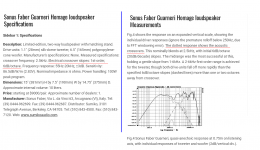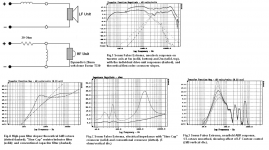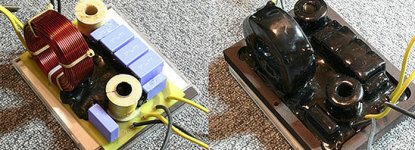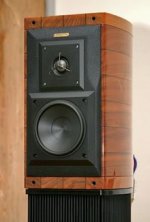I was reading a review of Sonus Faber Guarneri Homage and came across this little paragraph.
Does anyone know what on earth is a "Paracross topology"? Do you think it's some kind of BS? Do you think it may be a design by the marketing department and the engineers were responsible for final soldering?
Sonus faber Guarneri Homage Tradition stand-mount loudspeaker | Hi-Fi+
Crossover is a non-resonant design, with an amplitude/phase response optimised for the best balance of spatial/temporal performance. This is known as ‘Paracross topology’ in Sonus faber speak, and the speaker has a crossover point at 2.5kHz. This too is derived from the big guns, although time alignment is less of an issue here.
Does anyone know what on earth is a "Paracross topology"? Do you think it's some kind of BS? Do you think it may be a design by the marketing department and the engineers were responsible for final soldering?
Sonus faber Guarneri Homage Tradition stand-mount loudspeaker | Hi-Fi+
They mention progressive slope architecture but I can’t say if they mean that the progressive slope design is purely electrically implemented or it is the result of electrical x-over filter plus the inherent acoustic filtering of the driver(s)
Guarneri evolution
I tend to think it is the second (so that would be a marketing exaggeration), as Sonus Faber in the past was for very simple x-overs (6dB/oct allover or 6dB/oct for the woofer, 12dB/oct for the tweeter)
George
Guarneri evolution
I tend to think it is the second (so that would be a marketing exaggeration), as Sonus Faber in the past was for very simple x-overs (6dB/oct allover or 6dB/oct for the woofer, 12dB/oct for the tweeter)
George
Attachments
Attachments
It's just a marketing term. No reflection, they're a business & this is the way of the world we're currently living in, like it or not.
Be that as it may, without them being specific, which for obvious reasons they won't be, it could be almost anything. From the above, I'd suspect they're simply referring to using a low order filter to create an initial rolloff, which then increases through the mechanical rolloff of the drivers, as is ultimately the case with all moving coil driver based loudspeakers. Either way, I wouldn't get excited -there is nothing new in passive crossovers, hasn't been for decades, and can't be in the future.
Be that as it may, without them being specific, which for obvious reasons they won't be, it could be almost anything. From the above, I'd suspect they're simply referring to using a low order filter to create an initial rolloff, which then increases through the mechanical rolloff of the drivers, as is ultimately the case with all moving coil driver based loudspeakers. Either way, I wouldn't get excited -there is nothing new in passive crossovers, hasn't been for decades, and can't be in the future.
Last edited:
I guess two first order crossovers (possibly using some impedance correction as well) with inverted tweeter and pole frequencies "pulled apart". The Dynaudio Aries used something like that for instance but with an addtional allpass.
It is also possible that they use a series crossover - which they did in its simplest form in older small two-ways (tweeter and woofer inseries and just a coil across the tweeter).
Regards
Charles
It is also possible that they use a series crossover - which they did in its simplest form in older small two-ways (tweeter and woofer inseries and just a coil across the tweeter).
Regards
Charles
In that instance they appear to be using a normal filter for the woofer and an elliptic filter for the tweeter to better attenuate low-frequency content. I've also seen this in some KEF designs.
The slopes published for the Extrema don’t seem too different, yet see how simple the cross-over is. Their designer is very good in making cross-overs that match with the specific drivers.
Sonus Faber Extrema loudspeaker | Stereophile.com
George
Sonus Faber Extrema loudspeaker | Stereophile.com
George
Attachments
The slopes published for the Extrema don’t seem too different, yet see how simple the cross-over is. Their designer is very good in making cross-overs that match with the specific drivers.
Sonus Faber Extrema loudspeaker | Stereophile.com
George
There is a serious dip of around 10db (if I read the scale correctly) around 2 - 3KHz. My guess is the speakers will sound very "musical". But on the other hands, with simple xover, it may be what they are looking for.
I look through a lot of Stereophile speakers measurements and a lot of them have strange dips and peaks that I wouldn't let it go on my own diy projects at least to the best of my ability. I've seen some B&W speakers where the midrange is like 5db above the bass region. And some Dynaudio stuffs have some big peaks and dips that makes me rethink whether freq. response actually matters.
It does. Sonus used to cross their tweeters with a resistor and an inductor (they weren't the first). This approach is elegant but less versatile, and not well prioritised, but appealing to those who don't like capacitors. Less so to those who like a smooth response.whether freq. response actually matters.
This speaker appears to have a notch below the tweeters passband. They claim their crossover is non-resonant, I don't know where to start with that
Last edited:
I think it was the Red Queen in Alice in Wonderland who said that "When I use a word, it means exactly what I want it to mean"! I do this too. See, the word is not the thing. For instance if I use the word OAK TREE, it doesn't describe the Squirrels or the smell or the shade from the sun on a hot day. 
Thus it is with "Paracross".
In fact it seems to refer to aperiodic or damped reflex bass here. It's not rocket science. You just stuff or damp the reflex port and it ends up nearer closed box with a bit more deep bass. Somewhere between 12dB closed box and 24dB reflex lies aperiodic 18dB "Paracross". And it does make the impedance flatter and more amp friendly.
6db filters are just audio hoey, IMO. In practise you always end up nearer 6-18dB/octave when you take mechanical rolloff into account. I have some screenshots of the SF Guarneri, built on Violin lines with stuff like lead and rubber damping on the cabinet at a silly price. Probably sounds OK with classical. Heavy-metal headbangers must take their chances. Seems a reasonable idea to damp coils with hotglue or tar. They are quite lively and resonant and microphonic, IMO.
Thus it is with "Paracross".
In fact it seems to refer to aperiodic or damped reflex bass here. It's not rocket science. You just stuff or damp the reflex port and it ends up nearer closed box with a bit more deep bass. Somewhere between 12dB closed box and 24dB reflex lies aperiodic 18dB "Paracross". And it does make the impedance flatter and more amp friendly.
• Lilium - Low frequency speaker Lilium - Loudspeaker cabinet design with tuned mass damper“Paracross topology”. The impedance at low frequencies is controlled for a clear and friendly amplifier performance.
6db filters are just audio hoey, IMO. In practise you always end up nearer 6-18dB/octave when you take mechanical rolloff into account. I have some screenshots of the SF Guarneri, built on Violin lines with stuff like lead and rubber damping on the cabinet at a silly price. Probably sounds OK with classical. Heavy-metal headbangers must take their chances. Seems a reasonable idea to damp coils with hotglue or tar. They are quite lively and resonant and microphonic, IMO.
Attachments
I think it was the Red Queen in Alice in Wonderland who said that "When I use a word, it means exactly what I want it to mean"! I do this too. See, the word is not the thing. For instance if I use the word OAK TREE, it doesn't describe the Squirrels or the smell or the shade from the sun on a hot day.
Thus it is with "Paracross".
True. Pure marketing. A necessary evil in this day & age unfortunately.
In fact it seems to refer to aperiodic or damped reflex bass here.
Not as far as I can tell. All the references are related to the crossover rather than the box, & are probably referring to a notched 1st order or similar. Sonus have always described their mildly resistive vents as their 'stealth reflex port'.
6db filters are just audio hoey, IMO.
I'm with you there Steve. A lot of compromises and precious few advantages.
In practise you always end up nearer 6-18dB/octave when you take mechanical rolloff into account.
Ultimately true, but in fairness you can have 6dB/octave through the transition band, ultimately increasing to a higher order once the mechanical rolloff is factored in (or any stopband notches, additional filtering &c. for that matter). Depends on the flat BW of the driver on the baffle & the crossover frequency.
Should be:
Thanks Pietro.
They have patented the series resistor ("resistance greater or equal to 6-7 Ω") and the parallel inductance ("in the order of hundreds of µH") at the tweeter branch.
Why an inductor in parallel instead of a capacitor in series? Their reasoning:
"...the reactive component, which consists of the inductor, is placed parallel with the loudspeaker. This means that this component performs, with respect to the signal, a shunt or derivative function to an extent which decreases with the increase of the frequency and which therefore is close to zero when the signal is within the pass-band. Therefore, in the conventional case, the signal must cross the reactive component in order to feed the loudspeaker. On the contrary, in the device according to the present invention, this does not occur and the effect of the reactive component is to tend to cancel itself as the frequency of the signal tends to increase. In particular, this difference operates in favor of the quality of reproduction which is not limited by the quality of the reactive component being used."
George
So shunt components are irrelevant? This is how many DIYers used to talk, but a 'professional' appealing to a misconception, I'm not as sure. This is such an old view that reminds me of the automotive industry, which referred to the capacitor in an ignition system as a condenser until recent changes in technology.is not limited by the quality of the reactive component being used.
- Status
- This old topic is closed. If you want to reopen this topic, contact a moderator using the "Report Post" button.
- Home
- Loudspeakers
- Multi-Way
- What is "Paracross topology" xover?




